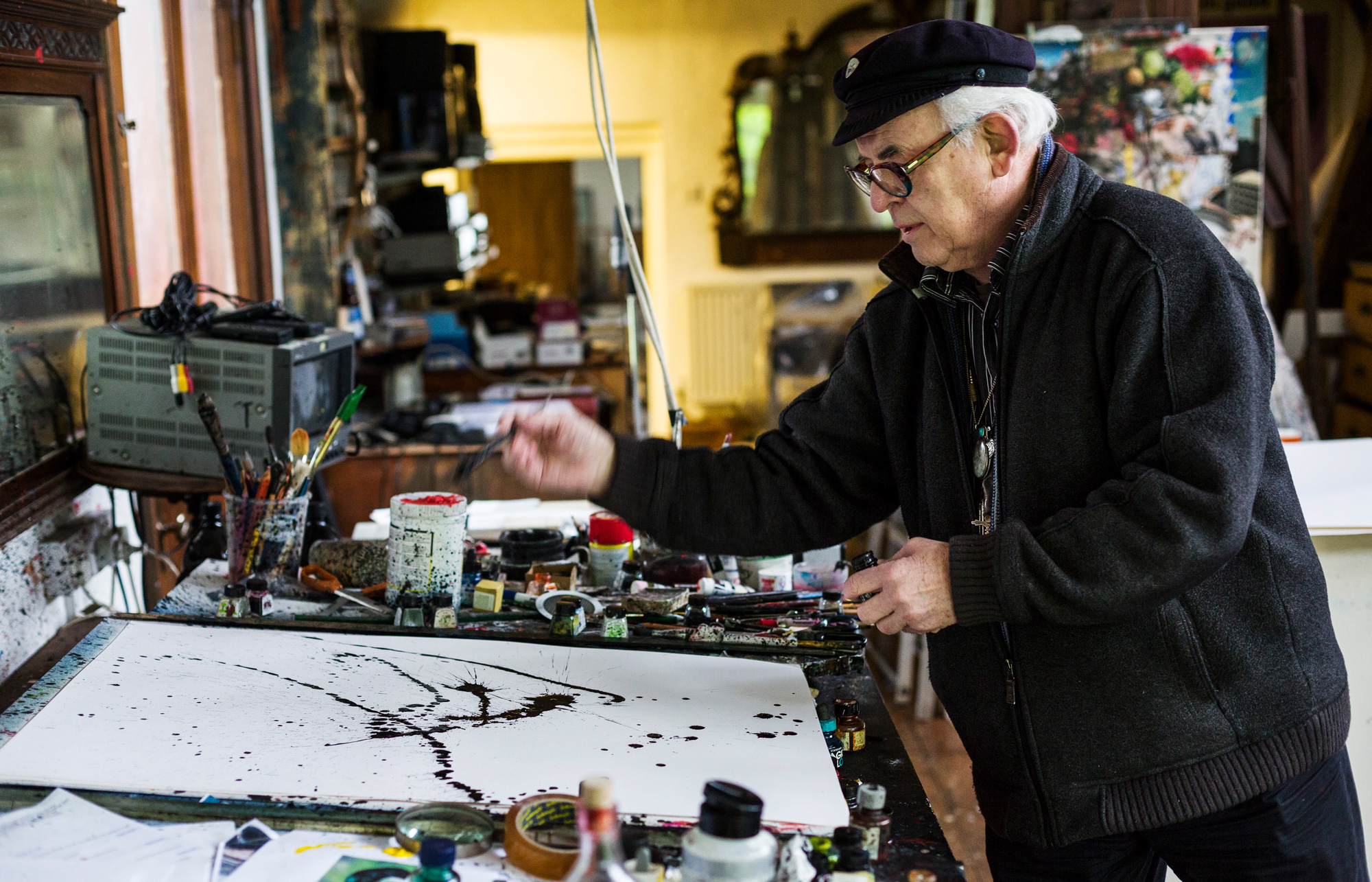
Ralph Steadman
The Crucial Comic
Interview by Gabe Scott // Portrait by Rikard Osterlund
Ralph Steadman has spent a lifetime conceiving and crafting images that are each a unique event. His audience responds to his personal artistic morality with pause, reflecting on how individual actions can determine a collective direction for the future. The breadth of his work certainly has its crude roots in a searing and merciless sense of humor that flourishes in the political and societal arena, but not to be overlooked is his keen appreciation of modern art history. We may not have enjoyed the Steadman we know without the benefit of Jackson Pollock, Francis Bacon and Willem de Kooning, but Ralph personally injected lowbrow, comic, street, graffiti and the art of resistance into the milieu. His vast influence is that significant, and it has directly affected the creative impetus for so many artists, actors and performers we admire today.
As a young adult, already possessed with a gentle generosity, he was so startled by the misery and depravity of the world that it became a life’s work to champion what is good and achievable—without pretense. Challenges motivate him, and each one questions perceived limitation. Over time, his work has become more personal, unwavering in his mission. Finally, we will have the opportunity to share this greatness in the form of a retrospective, preceded by a new book dedicated to benefitting our non-human, at risk cohabitants on earth. Steadman’s work will never cease to be relevant, as it is that of a true, master technician who reveres the best interest of all living things. There is no better time to drink it all in.
Gabe Scott: Since we last met on your 80th birthday, both Trump and Brexit have come to pass. Can you please tell me what the hell is going on? Of course, some of your best work was born in and around volatile periods of modern history. Has all this global political bullshit motivated you to act out in the name of creative decency?
Ralph Steadman: Yes, I want to hide. I don’t think I can remember a time as bad as this in politics. The entire time I’ve been doing political drawings, and I thought it was bad with Nixon.
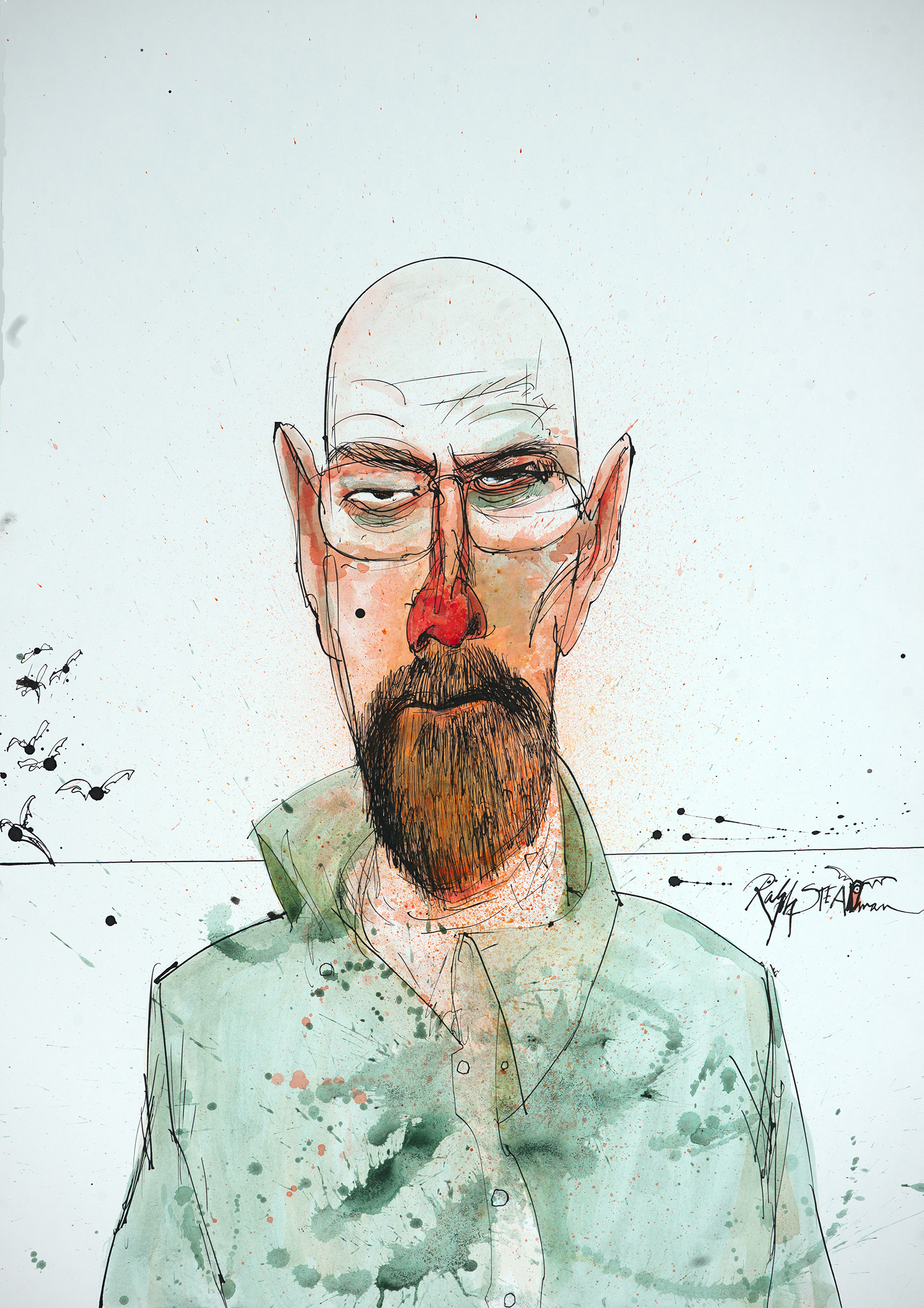
It’s that bad, in your opinion?
Oh, it’s worse than that—at least Nixon was a bonafide politician. He had a certain agenda, even if it was a slightly underhanded one. Now it’s just buffoons. Not only that, you've got this manic Islamic state stuff as well—that's a load of hooey, that's what that is. There's a lovely actor, the one from Better Call Saul, Bob Odenkirk. I met him and he gave me his book, A Load of Hooey. That's really what we're going through at the moment. It's such a shame, no one seems to have learned anything.
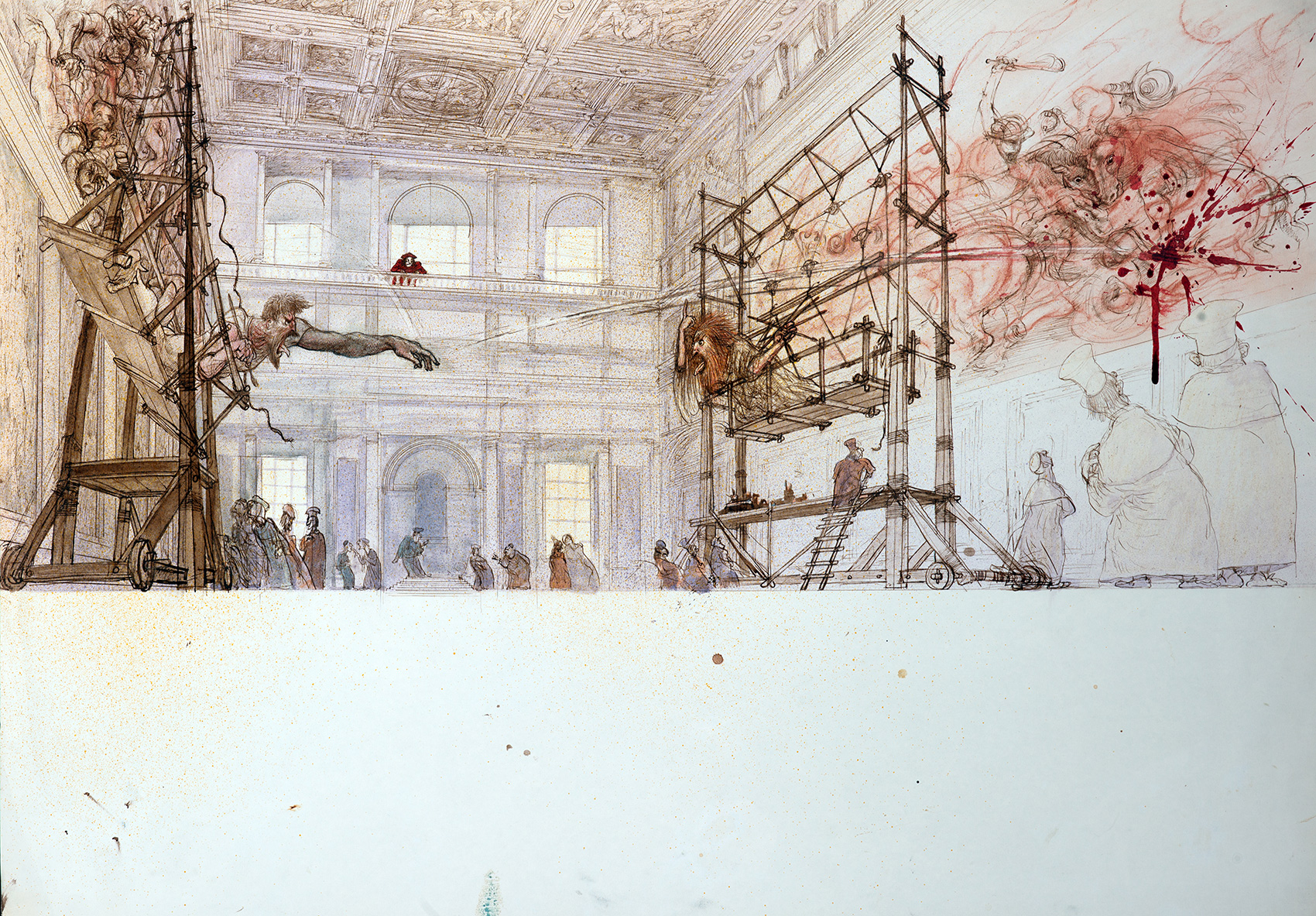
Perhaps it’s time to do a portrait gallery of total assholes. Ya know what I mean? Those people who would be presidents, those people who would be vice presidents, those people who would be leaders of any kind; those people we should follow… with a custard pie. It could be good! It’s all beginning to remind me of the very old classic film of Laurel and Hardy trying to take a grand piano upstairs.
I did a drawing of Bush with horns back in 2003, and it said, “In Texas, they say we swagger, but in Texas, that’s walking,’’ and, ‘’In Texas, they say we’re stupid, but in Texas, that’s an intellectual.” It’s not Texas’s fault, it’s just certain individuals that think they’re leaders, or visionaries or prophets. We need leaders, goddamnit! You only gave Jimmy Carter one go at it. Nice chap, you know, and you kick him out. He’s too nice. And a peanut farmer, to boot. He had a proper working life before he became a politician. You want stupid? Trump is just a practiced asshole. I’ve done the Trump thing, and he’s wearing a diaper…
Well then, this is probably the right time, socially and politically, to see a retrospective of your work tour the States, and it gets underway soon
Unless people feel it’s best forgotten; or that it belongs in a wiser time. Perhaps now we want idiot stuff. What was it I was saying the other day? “Always eat when you are hungry, always drink when you are dry, always sleep when you are tired, but don’t stop breathing, or you’ll die.” That’s kind of an idiot’s refrain about things. You’ve got to tell people that; otherwise they’ll stop breathing for no good reason. Just to do it. Please! Is there anyone out there that could be a leader? I mean is there nobody over there, philosophers of any kind?
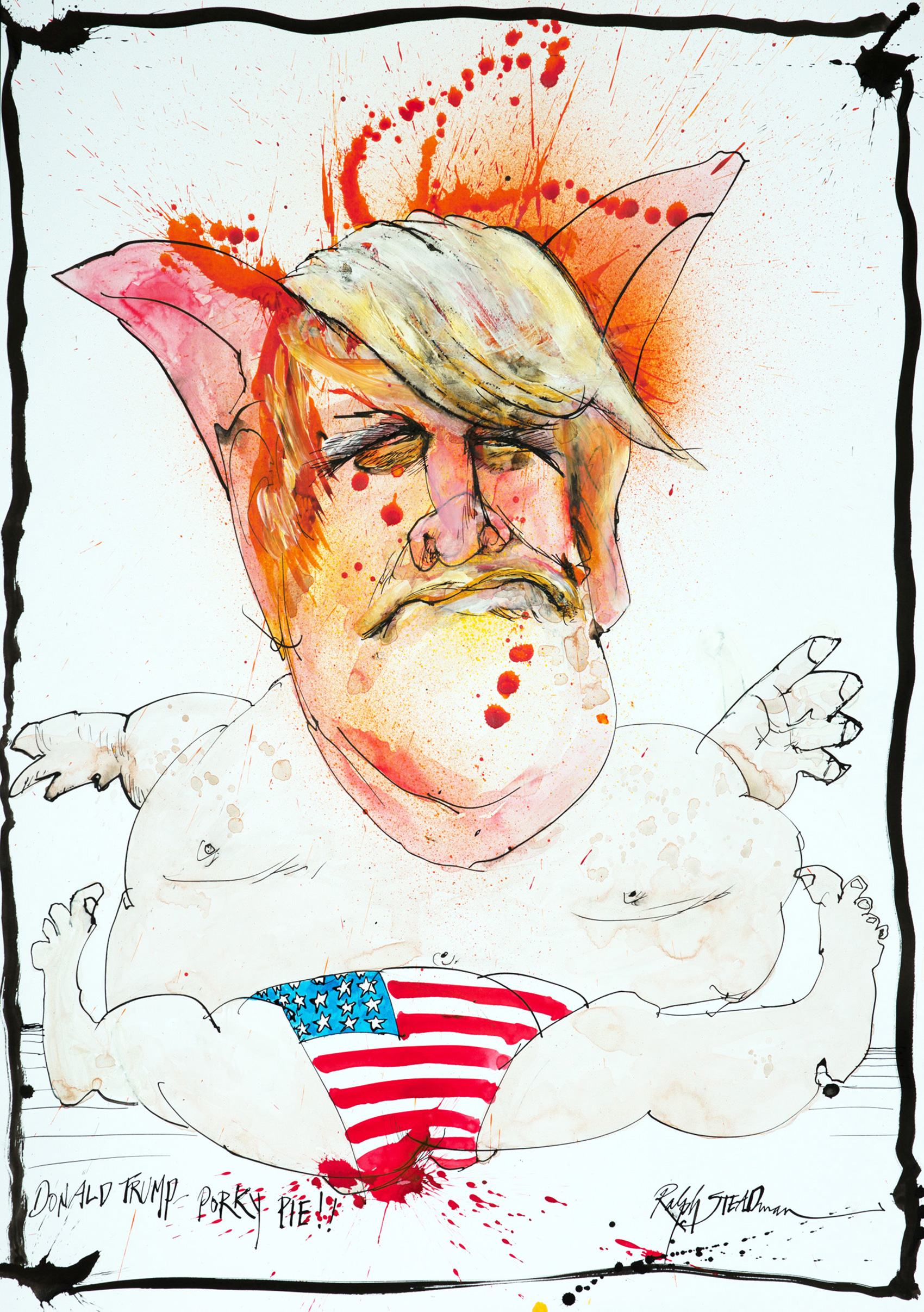
Perhaps you’ll successfully inspire our next savior! Do you consider authority something that you fundamentally rebel against? If so, where did that sentiment come from? How has that been a driving force for you, and does it still impel you today?
Yes. It was a tyrannical headmaster in grammar school. He was a terrible man who used to line the boys up outside his office and cane them for what seemed like no good reason. It was part of the system, and he could get away with it and seemed to enjoy it. It was part of his day, and his right, and he took it as easily as he would a cup of tea!
When authority goes wrong, it becomes abusive. It upsets everything and can upset the most gentle of temperaments. It always informs my work because it will never go away. That’s why I draw rubbish politicians and people who are not really politicians. It’s upsetting and it’s the only way I feel I can fight back; have my say, but not with violence, never with violence back at them. Now we are entering a time of articulated stupidity—not mindless, but very cunning wickedness. It’s heartbreaking. I hope there is one doubting Thomas amongst the younger ones to say, “Stop, Father, that’s enough.”
I’m sure that level of disdain was something that bonded you and Mr. Thompson all those years ago. Did you and Hunter ever discuss the roads you may have traveled down individually, if your paths had not crossed? Have you ever given much thought to your respective achievements and how they may have differed, how different your lives might have been if that fateful friendship had not been forged
He was the one person I was meant to meet in America. We were like chalk and cheese. I loved the way he wrote and pointed me in the direction he wanted me to observe, and I was shocked and horrified, delighted and surprised by people’s stupidity. Some of the early bits of writing I've come across are very apprehensive and ordinary. Hunter was really feeling his way, so to speak. If I hadn’t met him, I might have come home without doing anything—maybe carrying on with Private Eye and Punch, but I went to America because I was getting bored of that way of doing things.
Do you think your partnership was driven, particularly in the beginning, by curiosity about each other? Must have had a lot to do with it, yeah. And boy, he was really curious. When I actually went home and did some drawings, I remember when we did the Miami Republican Convention in 1972, I sent the drawings in, and he opened them himself in the Rolling Stone office, and, ''Holy God, Ralph''—every one of them was pure Gonzonian; they just didn't expect to get what they got. It just came pouring out at them. So, it was obvious that if there was one person I should have met in America, it was him.
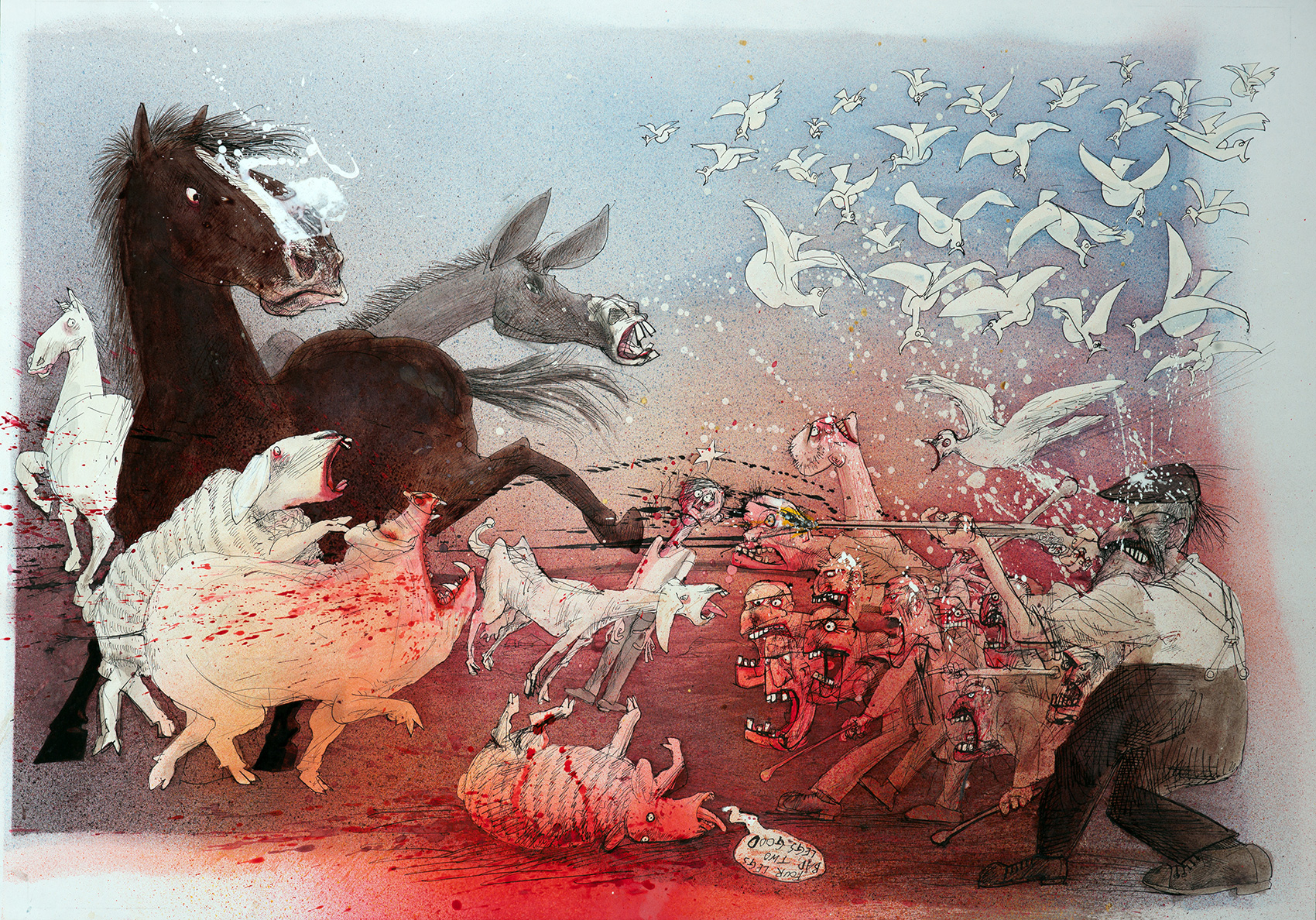
How do you think the difference in personality type and contrasting level of drug intake between you and Hunter affected your working dynamic?
People would meet him, offer him a pill, he would eat it, and then say, ''What was that?'' Eat it first then ask what it was—he didn't seem to worry. To him, it was part of his philosophy on life; taking it the way he wants to go, the batty craziness.
How was your attitude or approach different in that respect? Would you consider it sort of a yin and yang?
Yes, I think yin and yang, really. The only time I did drugs with him was for the America's Cup, where I took psilocybin—he was taking them all the time, and I was seasick, so I asked what he was taking, and he said, ‘’Well, Ralph, these are just pills, you see.” So I said, ‘’Well, would it help me at sea?'' So I took it and, of course, after about a half an hour, I began to completely lose my mind, and Hunter said, ‘’Here's two spray cans, Ralph, what are you going to write on the side of the boat?'' So I said, ‘’How about fuck the pope?'' And he says, ‘’Are you religious, Ralph?'' which was such a wonderful reply, you know… And we luckily got caught, otherwise I doubt I would have left America. It was the most criminal idea I've ever had, to write something on the side of a million dollar yacht. Anyway, we just hit it off because we were so different. He just thought I was a weird Welshman—he said to me, “They said you were weird, but not that weird.”
You’ve been so diligent about maintaining possession of your original works, which is one of the aspects of this retrospective that is remarkable, mostly all provided by their creator. I’ve been curious, what made you to decide to keep all of them over the course of your life, and how did the Kentucky Derby works get away all those years ago? We must locate them!
I have one of them. Somebody kindly sent one back after all this time and said we ought to have it back. The others were sent trustingly to San Francisco to be published in Scanlan's Magazine, edited by Warren Hinckle III, and they never returned them at the time. The rest of the Rolling Stone work was bought by Jann Wenner and hung around the offices of Rolling Stone where they remained until recently.
With things like my Alice in Wonderland, Leonardo da Vinci and Freud books, they seemed such a precious part of the result of my work, so important to the creating of these books, that I didn't want to just treat them like pieces of paper to be thrown away. Early in my career, you had to send the original, and they never bothered to return them, and a lot of them ended up just being taken by office people. It was the attitude back then. I made some of these drawings simply as a mere illustration, but I treated each with some sense of importance. It meant a lot to me, so I couldn't just treat them as bits of paper.
It’s fortunate that you paid the proper reverence. How does painting continue to fulfill you spiritually as an intellectual exercise? Or is that spirituality an aspect of your creativity that you prefer to keep close to the vest?
I cannot imagine what else I would do. I tried everything. I tried engineering and didn’t like factory life. Technical drawing led to free drawing at technical college in Wrexham, and innocence was an integral part of it. Contrary to popular belief, I am not a smart arse. I can cook a good boiled egg, though! A very important influence in my life was my teacher, Leslie Richardson. He really made me think about drawing in a very practical way, which included aesthetics.
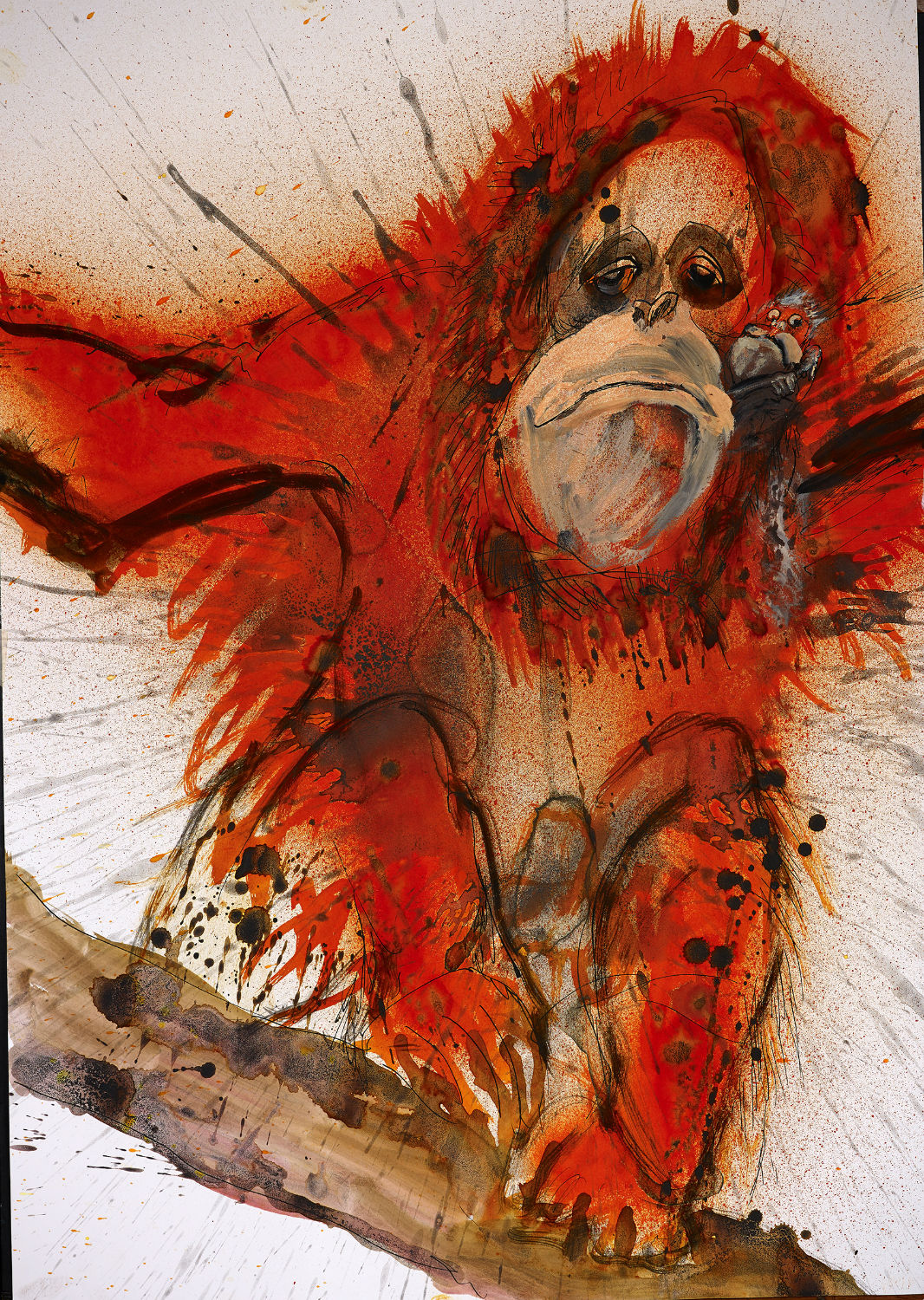
For you, there is a constant give-and-take between the gesturally abstract and representational. Can you tell me a bit about that interaction and your relation to each?
It’s pure chance informed by experience over a lifetime, that’s all—a general apprehensive fear of authority. “Authority is the mask of violence.” An image is a surprise sometimes, quite an unexpected surprise. Some things turn out well, and some things I find it quite difficult to like. I pursue it until it looks like something.
There's no such thing as a mistake; a mistake is only an opportunity to do something else. You let the paper discover things for you. It's reflected like a conversation you have with the page. You're looking at it and letting it tell you something, that's how it is.
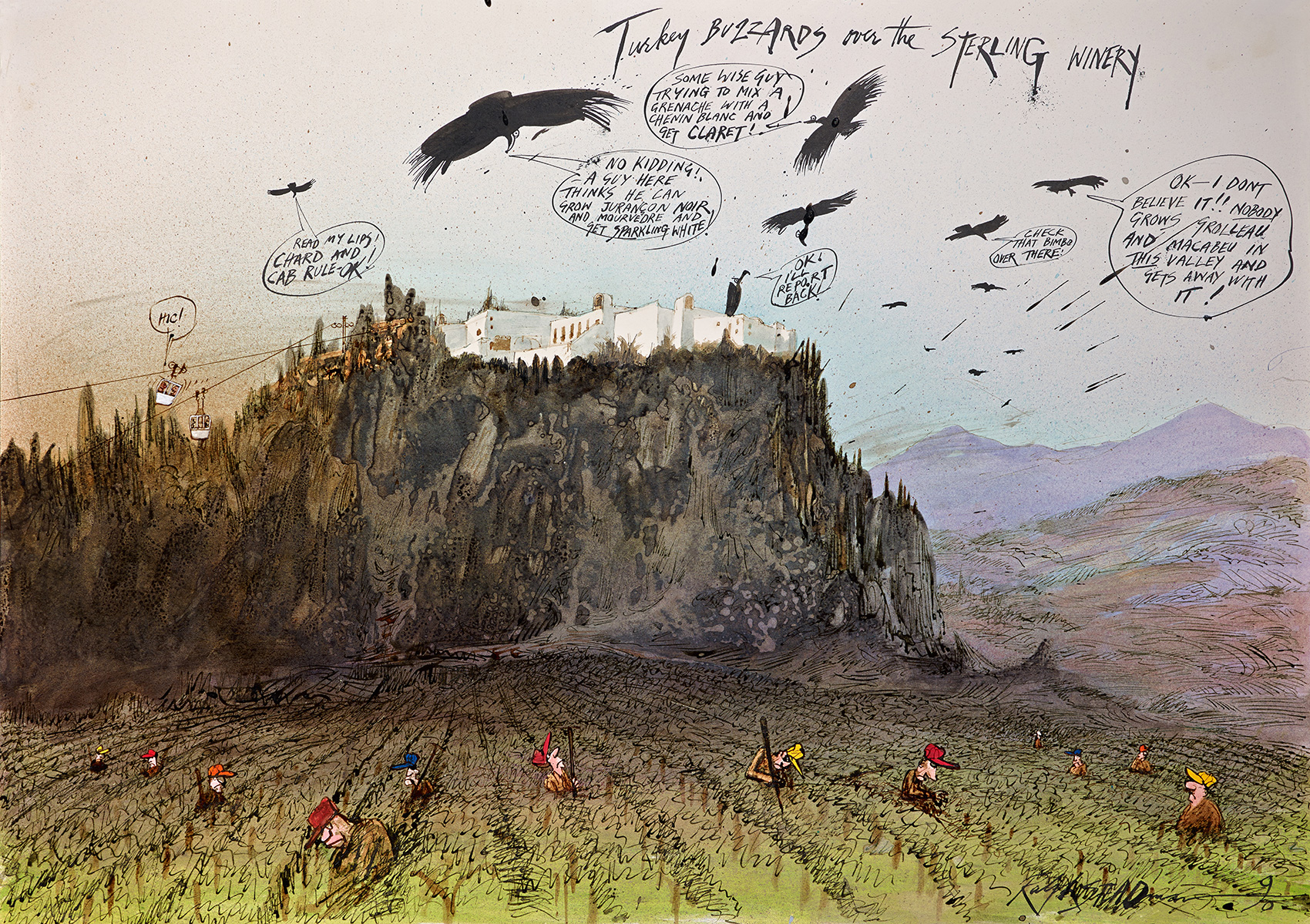
What does it feel like for you to make that first, resounding gesture, a splatter or any initial marking on a piece of paper?
Sometimes a wonderful surprise; but again, that's an opportunity to do something else with it. I'm doing a picture at the moment—there's a spider in there, there's going to be an Indian python down here, looks like there's an eye in here, another snake here, so I've got to finish this off somehow. I've still got a long way to go on it. I've just begun, but that's how crude it starts. And then, eventually, hopefully it becomes something else. This here could become something too—ah yes, there's some kind of creature that has yet to emerge, or it could be a person.
What about some of the three-dimensional renderings you’ve collaborated on? Your Vintage Dr. Gonzo and Bats Over Barstow collaboration with Jud Bergeron—was that the first time you had any of your characters formally cast in metal? How did that project come about, and was there something about Jud's work that made you want to interpret or replicate such an iconic work?
No. I have a small model cast in bronze that I modeled out of clay. It is of a lion with a huge, gaping, roaring mouth. They only cast two, one for me and one for the man who cast it. For Vintage Dr. Gonzo, I was asked by Brian Chambers of The Chambers Project, through our agents, if it was something that I might be interested in working on. I worked with him and Jud, and we had some phone calls and Skypes, and they were just excited about the project and determined to get a real feel of the piece and the man who inspired it. Jud’s a nice man, he has an expressive use of detail. He loved that I mimicked how Hunter walked and stood. I sent him photos, and he appreciated all the help. He wasn’t just a chancer. I made sculptures out of garbage and bits of machinery for a set called Red Alert in the 1990s. They are all down in the cellar at the moment. They are very heavy!
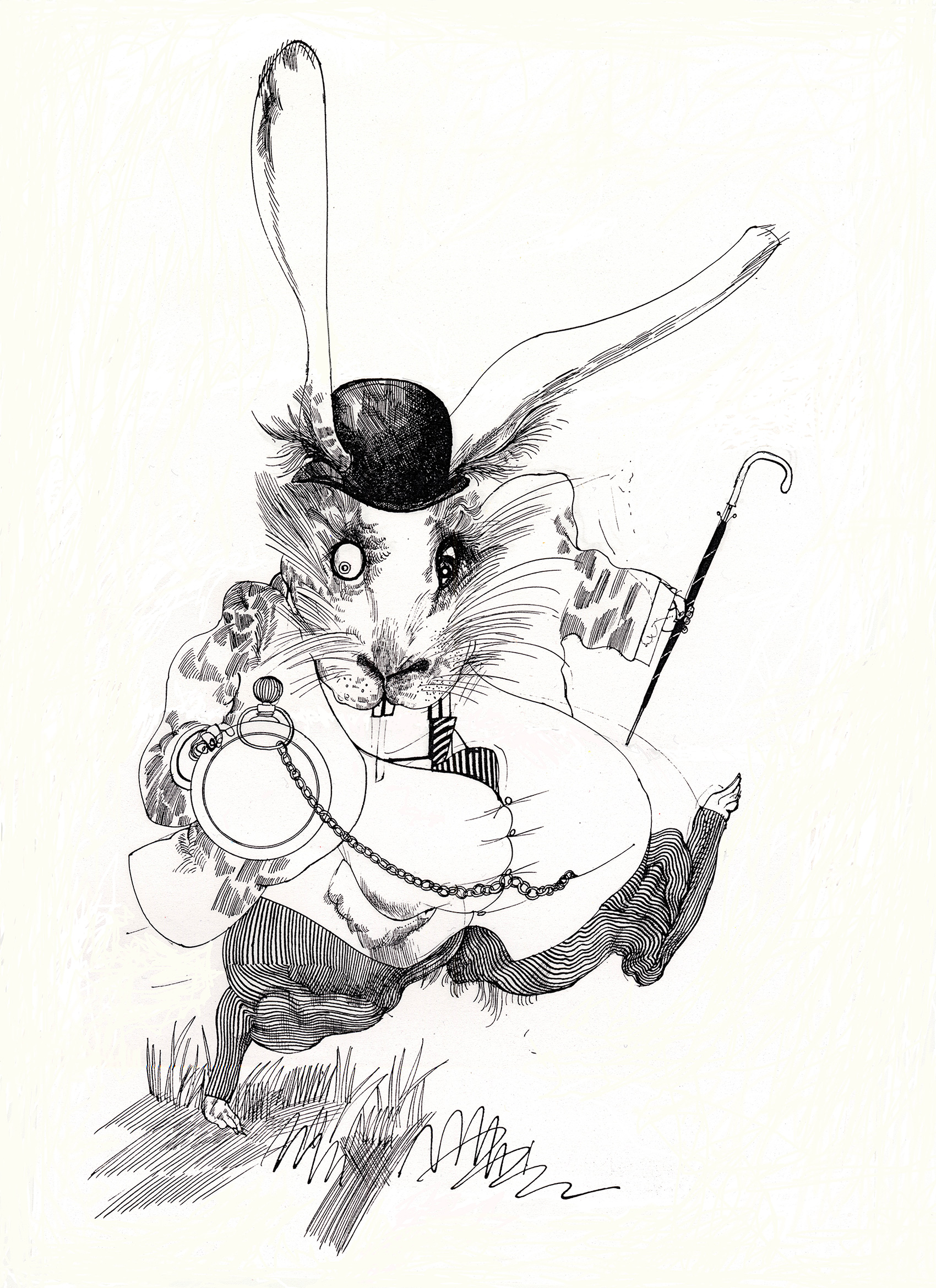
Over the last few years, you’ve been occupied with avian philanthropy and a concern for all life on our planet. Exotic Boids and Nextinction were the first two in a trilogy centered around environmental awareness, and now you are set to release the third book, Critical Critters. Your partner on these projects has been documentary filmmaker Ceri Levy; can you talk a bit about your working dynamic, the sense of humor you both seem to share, and how you’ve infused that into your process?
I blame Skype. I talk to him on Skype and then I send him a rude email. The more disgusting and rude it is, the better. Punning was always in the air. We like puns a lot and silly jokes! Plays on words.
Is it true that Critical Critters was partially born of a happy accident? How did you turn a jar of slop into a stylistic innovation?
I spilt some water on a piece of paper by-accident-on-purpose, and I thought it was very interesting and wondered what happens when it dries. It surprised me because when it dries, the dirty water separates into dots and texture. It denies the mechanical process of color printing because it is all so random. Each animal sort of evolved from the happy accident. The made up ones just developed. There was one that was just a messy blot, and it became a Dratsab and a Baby Dratsab in a onesy. Dratsab is Bastard backwards. It's my dirty water period.
In terms of stylistic critter depiction, how were you able to strike a balance between abstraction and scientific representation?
By talking bullshit, really. No, I didn't really worry too much about getting a scientific representation. But each animal is so unique, anyway, that I just saw their individual features. The Orangutan and the Bonobo are both apes but completely different—you cannot muddle them up.
In reference to the dirty water period, did you find yourself manipulating the residue from your tools and brushes, or did it simply evolve in a completely organic way? Does each critter at least partially inform the next, simply by virtue of sharing the same drinking water’?
That’s a good question, I never thought of that. I used to hold up the dried blots to Ceri on Skype, and we would try and see the animal within. When you add a set of eyes to something. you are halfway there. I never manipulated any of the blots, I just let them dry, and then we found that the shapes and textures decided for us what they would become.
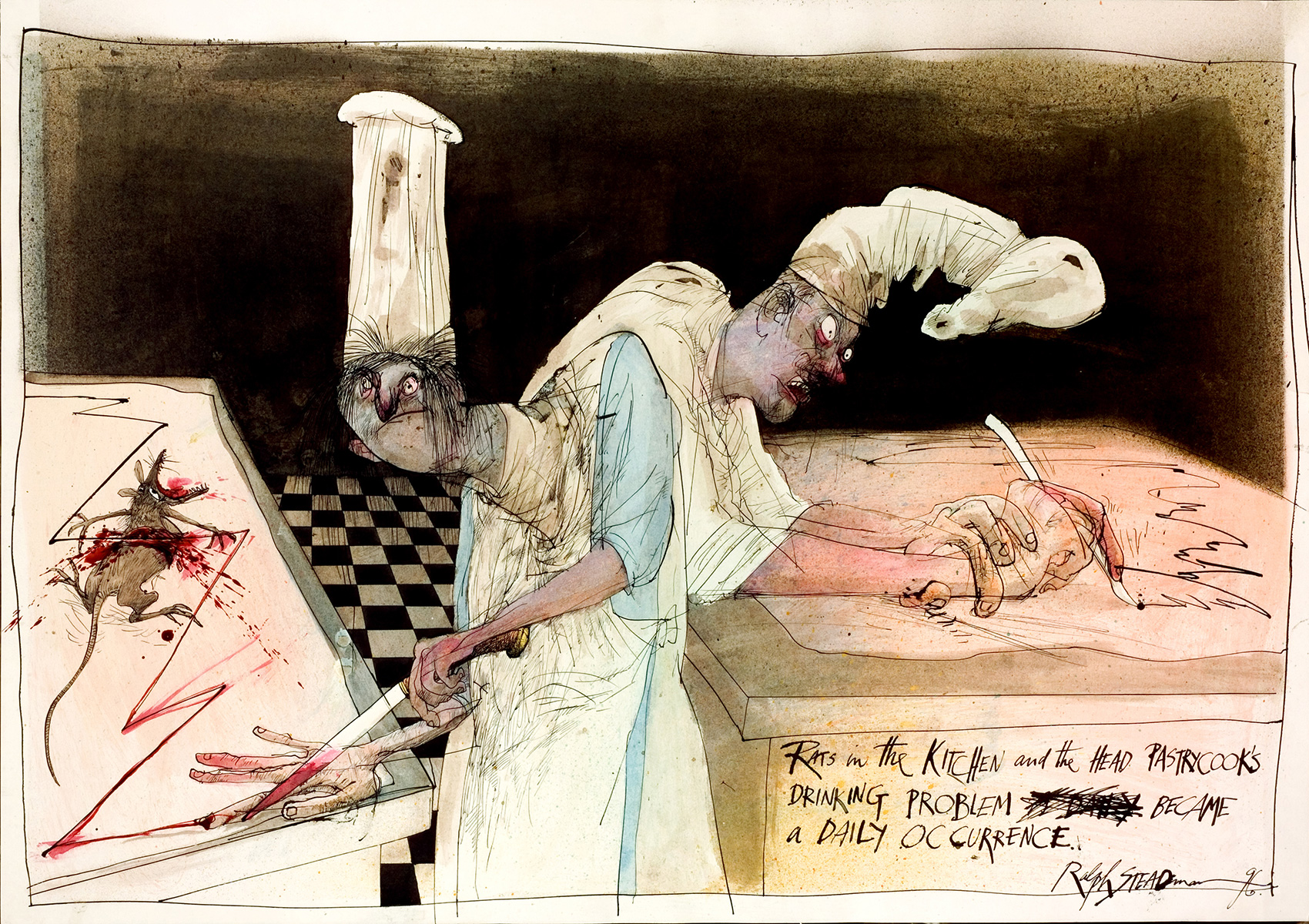
A particular quote of yours, in reference to the reverence you hold for Leonardo Da Vinci, is something that I feel holds a key to understanding the Steadman raison d’etre: “I recognized things about myself in him; that I was trying hard to be something rather special, and that’s not being swanky. It’s about trying to do something as definitively as I possibly could, that served the purpose it was intended to serve.’’ That kind of intent, the sense of moral and creative responsibility, is something that requires an incredible amount of courage and self awareness. How and when was it that you came to accept and understand this acumen? Is it something that has weighed heavily on you over the course of your life?
No, it's kept me going. It's kept the raison d'etre alive. You have to care about the drawings you do. They are more than pieces of paper. They contain a certain reason for doing anything. It's not just nine-to-five. I was fascinated by the Impressionists and all the artists like Van Gogh, Gaugin. We revere them now. They were so passionate about what they were doing. It wasn't just a job. In the face of ridicule, they carried on. It was almost part of why they kept doing it, because everything scorned them, and I took them as a gospel truth. Duchamp's approach was to take an object like the urinal and say, “It’s a work of art, and call it Dada, the first sound a child makes.” There is an element of subversion, but it is also a little like a child in that a child considers everything they do and everything in their world as absolutely crucial.
ralphsteadman.com





